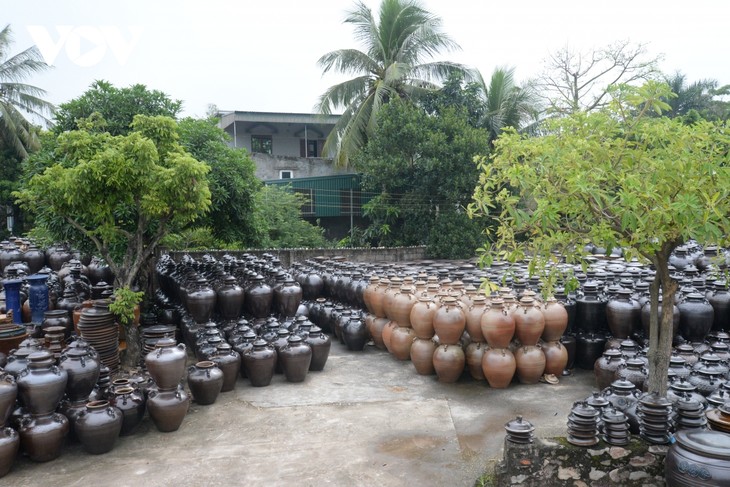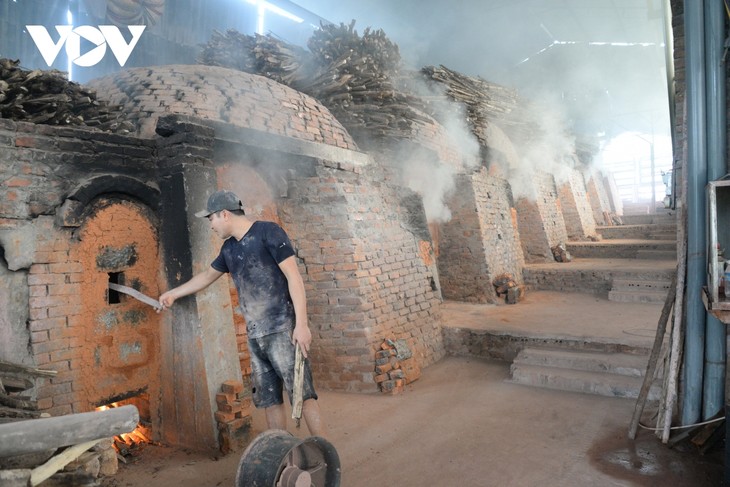(VOVWORLD) - Vinh Hong, an ancient pottery village in Dong Trieu town, Quang Ninh province, produces unique ceramic products and employs hundreds of people.
 Vinh Hong pottery, ceramic, porcelain, and glazed terracotta products – dishes, vases, and jars - are displayed in the front yards of local houses. (Photo: VOV) Vinh Hong pottery, ceramic, porcelain, and glazed terracotta products – dishes, vases, and jars - are displayed in the front yards of local houses. (Photo: VOV) |
We visited Vinh Hong pottery village on a late autumn day. The road leading to the village was inundated with the terracotta smell of burning pottery kilns.
Mounds of clay and kaolin covered by canvas lined the road. An abundance of pottery, ceramic, porcelain, and glazed terracotta products stood in the front yards of local houses.
Village elders say the craft dates back to the 18th century and was brought here by migrant potters from Hanoi’s outlying Gia Lam district.
Although Vinh Hong pottery village is not as famous as Bat Trang in Hanoi, Huong Canh in Vinh Phuc, or Chu Dau in Hai Duong province, Vinh Hong products stand out because of their beautiful designs, high impact resistance and durability, and bright enamel.
The Vinh Hong villagers still use wood to fire their pottery, says Nguyen Xuan Thong, the owner of a traditional pottery workshop in Vinh Hong.
Thong explained, "A wood kiln can fire several hundred pottery products at one time. Using wood makes the products durable because the furnace is annealed, and the cost is much lower than using a gas oven. A gas kiln can hold only a few dozen products, but a wood-burning stove can fire many large items, and that makes the price more reasonable for consumers."
 Vinh Hong pottery products are fired at a temperature of 1,200-1,300 degrees Celsius. Vinh Hong pottery products are fired at a temperature of 1,200-1,300 degrees Celsius. |
According to artisan Nguyen Dinh Cau, Vinh Hong pottery is fired for 24 hours at a temperature of 1,200-1,300 degrees Celsius. Other pottery villages in the Northern Delta fire pottery at 800 degrees Celsius. This makes Vinh Hong pottery products more durable and seamless and their patterns don’t lose their color because they are carved directly into the products instead of being painted on the enamel.
Making the mold is the most important step in turning out a high-quality ceramic product. If the mold is distorted or the coating is not right, the product will become cracked and blistered when it is fired in the kiln, according to Cau.
"Mold making for pottery products is the first step and plays the key role in creating beautiful items that meet the standard set by Vinh Hong pottery village. An important part of this step is making sure the mold has water absorption and hardness," said Cau.
In the past, all the Vinh Hong villagers were engaged in this craft. Then there was a long period when most of them, except for 17 households, switched to other occupations.
Pham Van Thang, Secretary of the Party Committee of Vinh Hong village and Director of the Thang Lan Company, says the village has begun producing large jars for storing wine, fish sauce, and rice.
This brings in an average profit of 1,300 USD per month per household and a stable income of 350 USD per month for hundreds of workers.
"We’ve shared our experience in production and sales with each other. As a result, despite the pandemic, we have maintained our production and sales," said Thang.
Vinh Hong products have been exported, and villagers have cooperated with small pottery producers in neighboring localities to establish the Dong Trieu Pottery and Ceramic Association to support each other in production and sales.
Vinh Hong is planning to combine pottery production with hands-on classes for visitors.
Le Van Tinh, Deputy Head of the Economic Section of Dong Trieu town, said, “In recent years, we have identified pottery as a craft in need of conservation and promotion. First, we re-organized Dong Trieu Pottery and Ceramic Association and built a collective brand for Dong Trieu ceramic and pottery products. Second, we worked with the Department of Science and Technology to form a local ceramic incubation center and helped businesses and production households introduce their products at trade promotion events.”